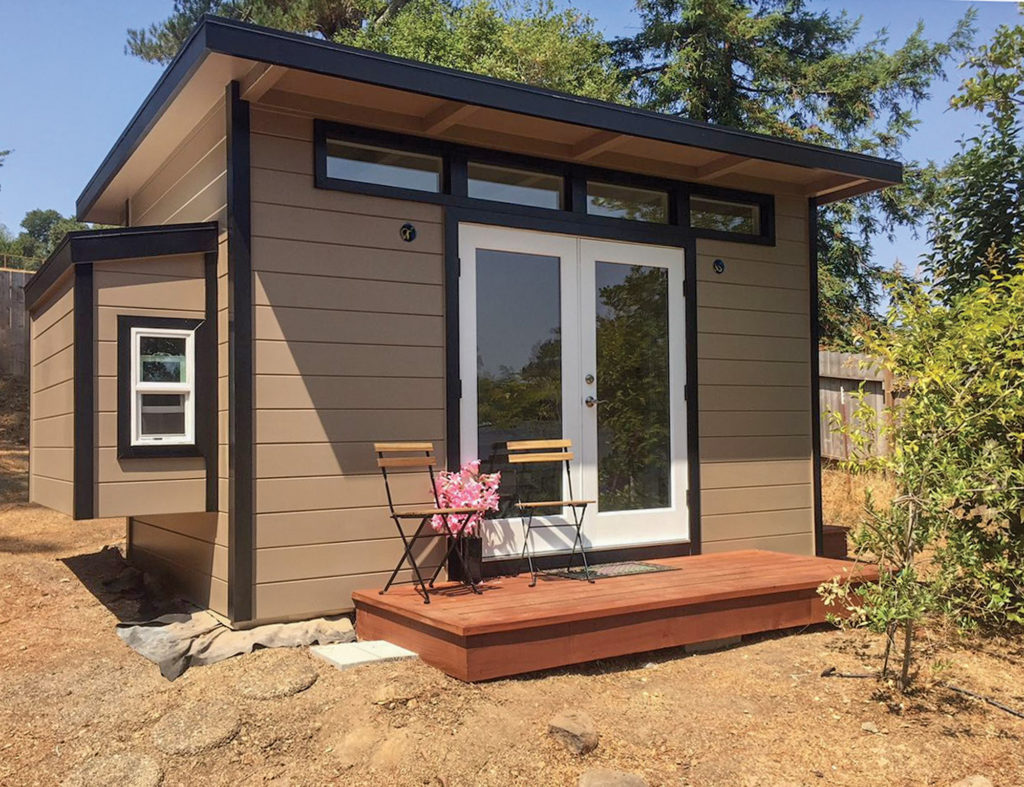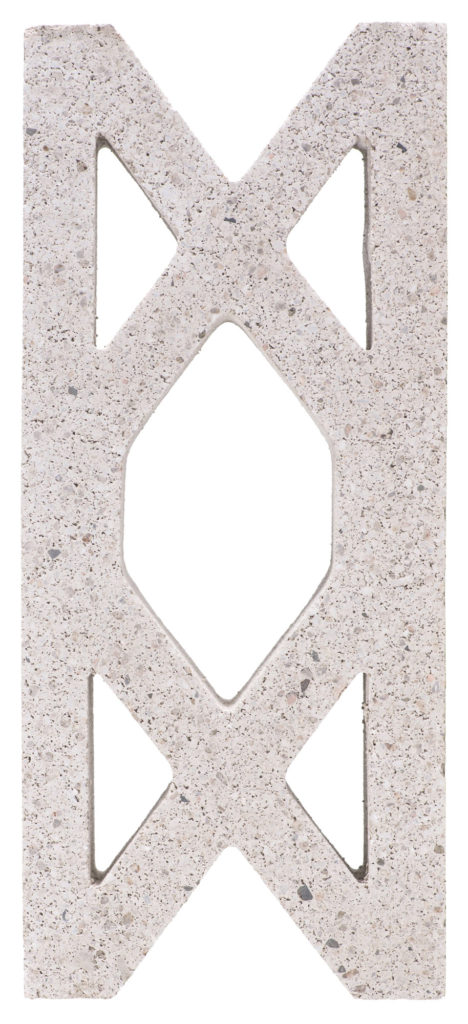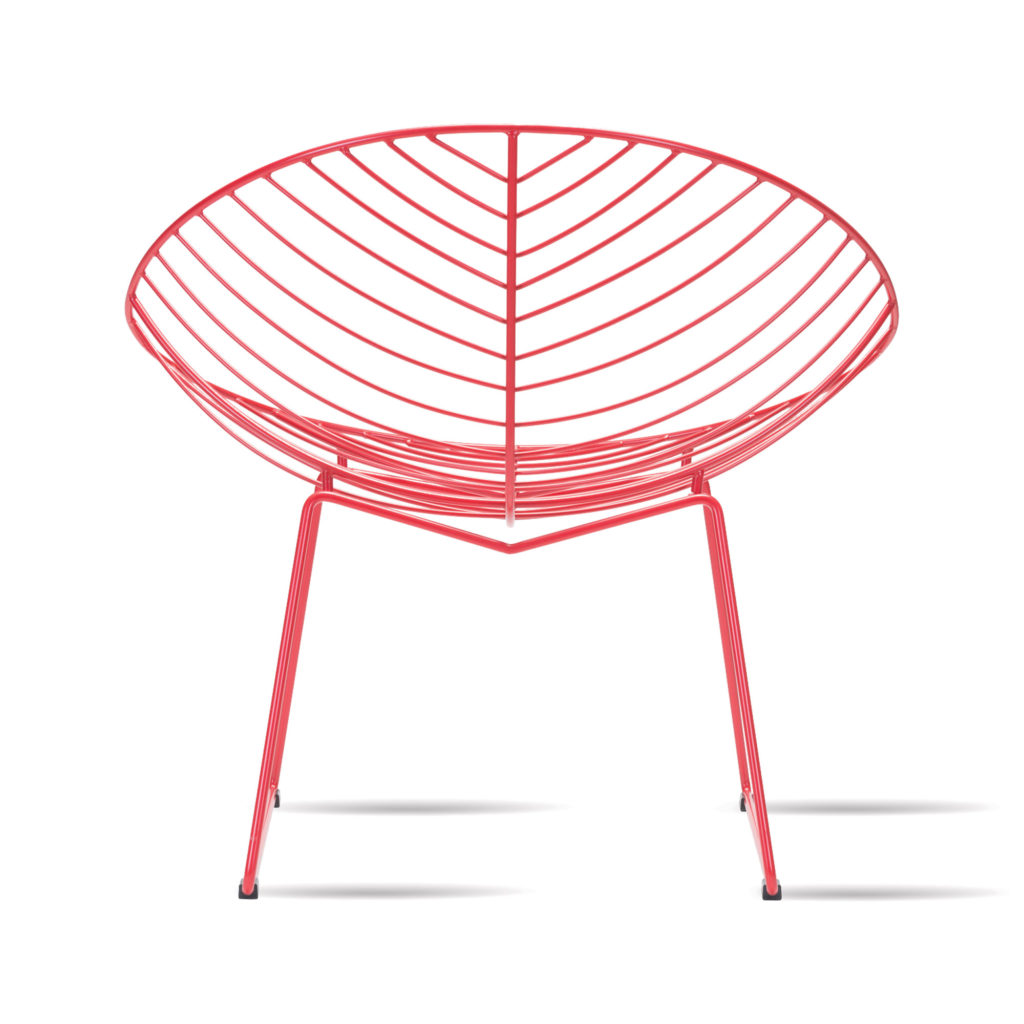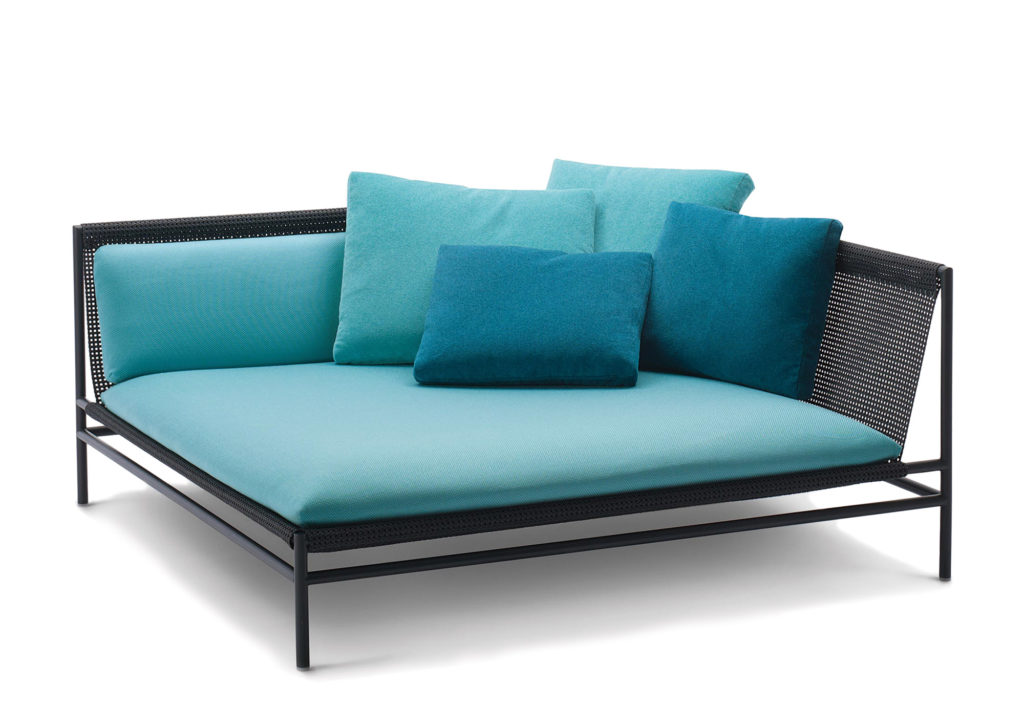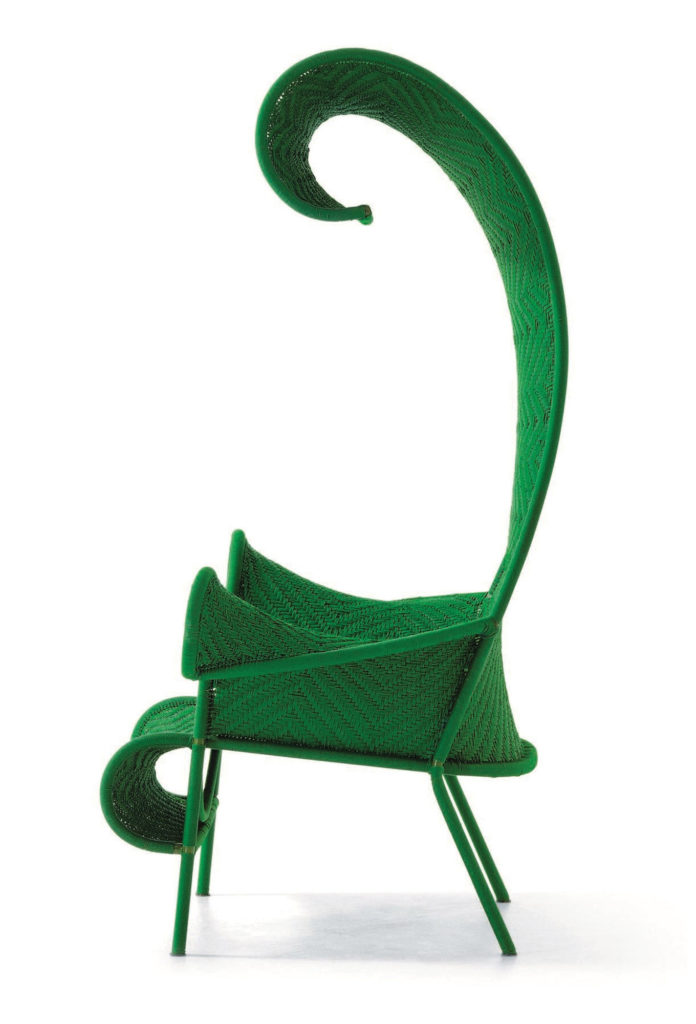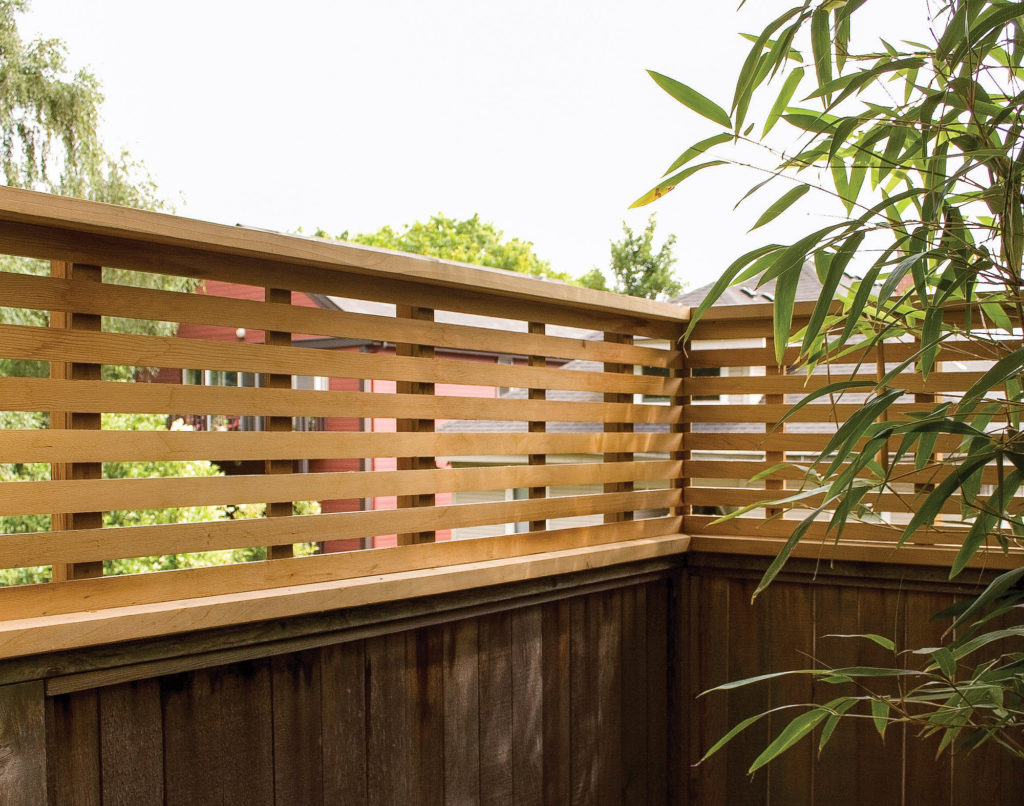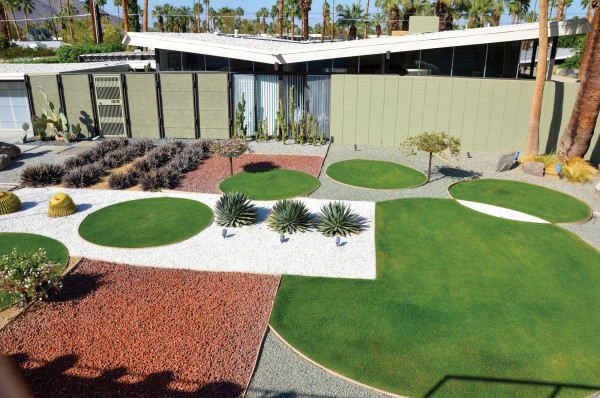
The 1956 butterfly-roof house in Twin Palms was designed by Palmer & Krisel in collaboration with Alexander Construction. The house has been restored by Chris Menrad, co-author of a recent book about William Krisel in Palm Springs.
A first-time visitor to Palm Springs discovers an architectural dream world. Sprawling tracts of consistently Modern, one-storey houses are a singular vision taking us back to an optimistic time. At least as amazing are the small but very public front yards. Some are geometric carpets of varying colors and textures, obsessively manicured. With permeable gravel and varieties of succulents and cacti, others are perfect xeriscapes needing almost no watering.
It’s hard to reproduce the look elsewhere. Palm Springs and neighboring towns sit in a Sonoran Desert valley tightly ringed by mountains on all sides, screened only by tall, skinny palm trees. Cactus, agave, and bougainvillea won’t grow in Minnesota or New Jersey. Landscaping is by nature local. Some motifs, though, are recognizable. From coast to coast, you can find a slab porch on grade, pierced or dowel-like privacy screens, and patios.
Many houses built between 1940 and 1970 have lost their original hardscape, landscape, and gardens. Often the property is simply overgrown, bearing the additions of several generations of gardeners. Other houses lost elements during an ersatz “colonial” remodeling. How do we begin to design an appropriate landscape today?
Live in the house for at least a year before considering a makeover, noting changes in each season in sun exposure, wind direction, drainage patterns, and local annoyances. How did you end up using the existing space during that year? Take cues from the house: clean lines and a modern aesthetic suggest that hardscape and landscaping should follow suit. Other houses of this period tend toward cottage or a historical revival style. Consider the suitability of straight lines or curves, symmetry or asymmetry, strong silhouettes or a profusion of flowers, seasonal variations, and the color palette or palettes.
Materials should be appropriate; using a lot of red brick in a neighborhood full of cedar shingles and granite may not be the best fit. Understand your growing zone and choose a sustainable plan. Do you need to address a steep drop-off, or screen a busy road? Solve any drainage problems before you start.
If you are truly starting from scratch, consider hiring a landscape designer. That way you get a master plan and avoid stop-and-start do-overs. The designer will help you refine your vision. A landscape professional will know how to address any site problems and what plants thrive in your micro-climate.
As an overall design, Mid-Century Modern works best with low-slung houses like ranches and Contemporaries. For other house types, it’s best confined to, say, a patio or pool. Simple lines and lack of clutter define the look. Furniture and walls are low to the ground. Concrete, stone, or brick provide neutral color as a backdrop, punctuated by solid and often bright accents. Circles, squares, diamonds, and triangles show up in ornament and the shapes of planting beds. So too do amoeboid and kidney shapes, especially for pools. Surfacing materials are used in combinations of pea gravel, tumbled stone, pavers, concrete, recycled rubber, decomposed granite, and real or artificial turf. Walls and screens made of breeze blocks—those pierced concrete blocks with geometric designs—all but define the era. Allowing airflow and creating moving shadows throughout the day, breeze blocks belong in sunny California but create a mood wherever they are used. Screens and raised planters, backyard fences and hedges provide partial enclosure for a sense of privacy. Slatted overhangs and patio roofs or awnings mitigate direct sunlight.
The Southern California style is about concrete and cactus. But in most of the country, mid-century gardens were lush and green with a preponderance of wood elements. The hardscape and beds that contain plantings still can be tidily Modern.
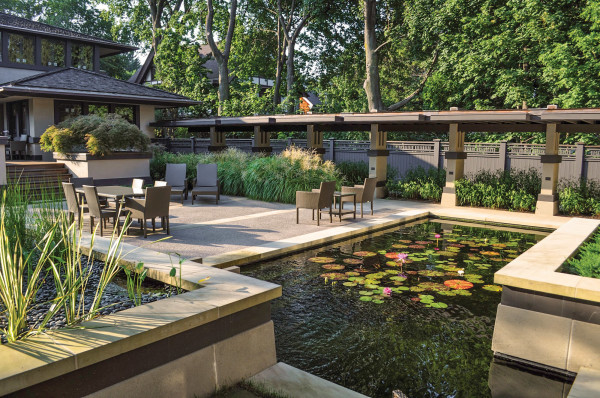
Bayer added a lily pool behind the patio. The pergola was designed by Bero Architecture.
Courtesy Bayer Landscape Architecture
An Iconic Landscape
The 1908 E.E. Boynton house in Rochester, N.Y., is the furthest east of Wright’s Prairie homes. At first its property encompassed four city lots, with expansive gardens, a reflecting pool, and a tennis court part of the original design. When the property was subdivided in the 1920s, more than half of the landscape was lost and the relationship between house and site greatly affected. Successive owners over the next 80 years introduced garden revisions.
Private owners Jane Parker and Fran Cosentino bought the landmark in 2009, forming a trust to restore the house and rehabilitate the gardens in a manner true to Wright’s original vision. Adhering to the Secretary of the Interior Standards, the design team at Bayer Landscape Architecture did extensive primary research, all in consultation with the Frank Lloyd Wright Foundation. Site features that had been lost, or those noted in original drawings but never fully realized, were then reinterpreted for the smaller site.
Mark Bayer simplified the landscaping to highlight the architecture. A driveway was removed in front, and distracting plantings replaced by a grass carpet. The pergola’s covered walkway leads to a new lily pool. House and site once again are unified.
Mark H. Bayer, RLA, ASLA | Bayer Landscape Architecture | Honeoye Falls, N.Y. | (585) 582-2000 | bayerla.com
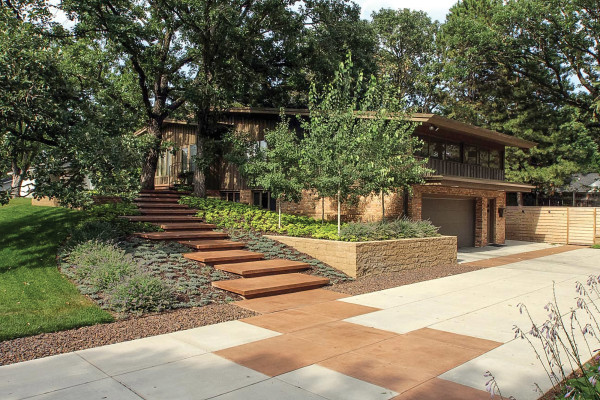
Large and flowing downward in a zigzag, the steps terminate at the driveway, where the same color provides continuity.
Courtesy Ground One
Step Class
When the owners of a Mid-century Modern house called in Minneapolis landscape firm Ground One. for help with a failing concrete driveway and drainage problems, they had no idea they were about to create an homage to Fallingwater in the front yard.
The existing concrete steps were steep and awkward, running straight up from the driveway and making a sharp turn toward the front stoop, explains landscape architect Nathan Anderson of Ground One.
Building a retaining wall with a large planting bed helped eliminate most of the drainage issues, but the owners wanted a softer, safer approach to the front door. Anderson’s solution is a series of large, raised steps made of integrally dyed concrete, which cascade from the front stoop and key into the driveway.
“Concrete is a period-appropriate material. These steps also pick up the colors in the foundation,” says Anderson, adding that concrete was also less expensive than stone. Building steps with a 3″ overhang required two interrelated processes: one concrete pour for the smaller bases, and a second for the larger slabs on top. The steps are reinforced with rebar, and lit from below by strip LEDs wired to a master line buried in the planting bed. “Once the ground covers fill in and become a carpet, a waterfall of concrete will appear to fall down through a bed of green,” Anderson explains.
—Mary Ellen Polson
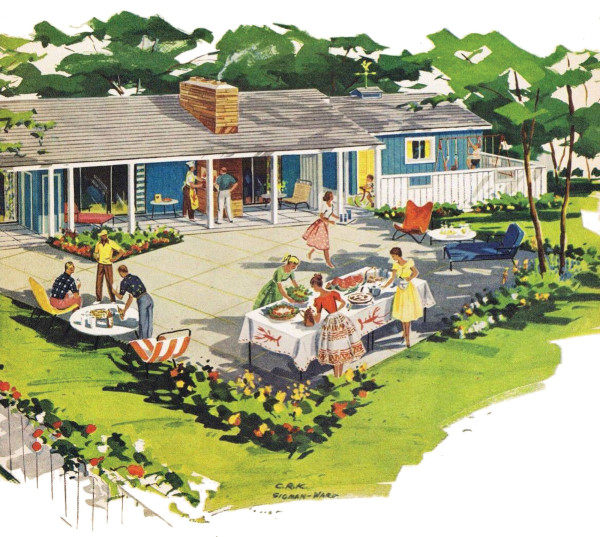
In a “dream home” illustration of the 1950s, a patio party is underway; note the large pavers, triangular planting bed, and fenced play area
Archives/Sigman-Ward Architectural Illustrators
An Emphasis on Backyard Living
By the 1950s, automobile traffic and television had made front porch-sitting a thing of the past. Architect-designed Mid-century Modern and postwar suburban ranches alike emphasized the family enjoying the backyard, privately or with invited friends. While the front yard remained in public view, rear yards were now enclosed by a tall fence or a wall of hedges. A patio on grade became the center of a yard with zones for play, relaxation, and outdoor dining.
The pictorial archive for this period is extensive, and shows that most residential landscape design was practial and pedestrian. Outside of California and several hot spots of Mid-century Modern design, the patio was surrounded by green lawn, specimen trees, and flower beds.
If the historical archive suggests a unifying theme, it is simplicity. Everything is lower to the ground. The pergola is no longer neoclassical or done in fancy saw cuts, but is rather a plain stick structure. Flower beds are smaller and contained. Concrete or pavers cover more of the outdoor space. Linear arrangements are common.
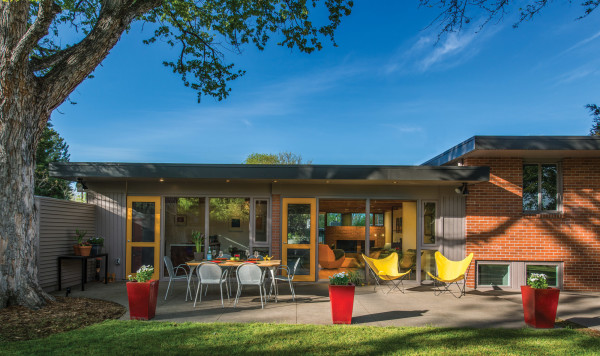
Mid-century Modern home in Arapahoe Acres.
Ed Lacasse Photography for Architectural Workshop
Denver Rebirth
Located in the historic Arapahoe Acres mid-century development, this 1954 house was damaged by a fire that destroyed the kitchen, carport, and rear elevation. The scope of work in its restoration and remodeling including main living rooms as well as the carport and exterior doors and windows. Throughout, the architects specified Mid-century Modern details, seeking out custom and period-sensitive millwork and cabinets. Making the indoor/outdoor connection seamless, the new kitchen opens to the patio and backyard through floor-to-ceiling custom glazing. Planters and furnishings give the outdoor space the right vibe.
Mark Bowers, AIA, LEED AP, NCARB | Architectural Workshop | Denver, Colorado | (303) 788-1717 | archshop.com
Still Made Today
1. Go MCM tiny with the Essential Eichler Shed from Backyard Eichler.Fully insulated and wired with finished walls, the 12′ x 10′ house has sliding doors, Eichleresque 1 /” grooved siding, and a beamed roof. Starting at $23,000 installed. backyardeichler.com
2. Coveting a Fifties patio vibe? Orco Block & Hardscape in sunny California offers concrete breeze blocks in nine classic patterns, including Pinwheel and the double-X Vista, available in a variety of tints and finishes. Pricing and shipping costs vary. orco.com
3. The Hyde Outdoor Lounge Chair from Boxhill Design has a wired leaf pattern and comfortable scooped seat that accommodates pillows. Made of steel and available in fade- and weather-resistant red, gold, or white, it’s 33 ” wide x 32″ high. $258. boxhilldesign.com
4. Designed by Francesco Rota for Paola Lenti, the Canvas Sectional Platform is the lynchpin of a series of modular sofa elements in weather-resistant steel with water-repellent cushions. Available from SwitchModern, the platform is 57″ square with a 15″ seat height. Call for price. switchmodern.com
5. The Shadowy Chair draws on such inspirations as parasol-covered European lounge furniture and African weavings. Designed by Dutch industrial designer Tord Boontje and sold by Hive Modern, it’s 63″ high x 41 ” wide x 35 ” deep, woven from strands of vibrant plastic on a steel frame; $1700. hivemodern.com
6. Strong lines and the longevity of clear Western red cedar make the Moderna Panel Screen from Woodway an enduring choice. Kiln-dried, sanded screens are 4′ x 6′ or 4′ x 8′ for $190–$293 per panel. woodwayproducts.com
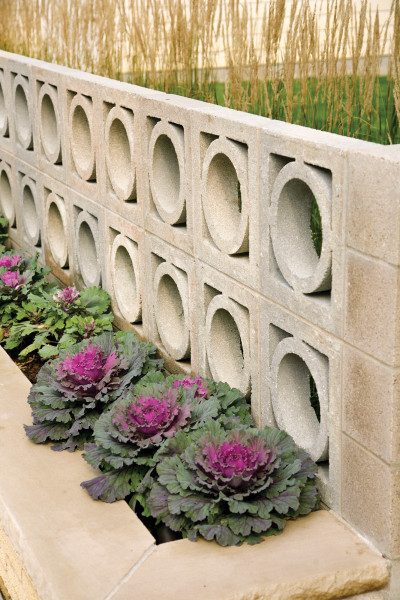
Architectural concrete blocks.
Courtesy of Ground One
Breeze Blocks
Nathan Anderson of Ground One in Minneapolis used architectural concrete block to partly enclose a patio for a 1950s Rambler. Here winters are severe, so walls are mortared and supported below grade to the frost line.
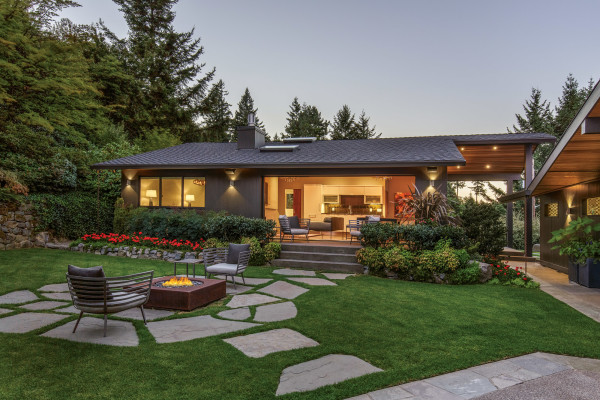
Large flagstones create a random pattern in the backyard lawn area, where an open patio accommodates a firepit. Three large glass panels slide into a wall pocket, making the sheltered patio part of the living space.
David Papazian for G S Architects
Seamless Outdoor Rooms
This 1957 Mid-century Modern residence needed a more functional floor plan as well as general revitalization. The main house got a partial second-level addition within the existing volume, preserving its original front gable, while the guest house (shown) was cut down to create a covered entry. The rear façade opens to a reimagined patio that flows from the glazed wall to flagstones leading to the firepit. A low stone wall and plantings follow the line of the house.
Timothy Schouten, AIA | Giulietti/Schouten Architects | Portland, Oregon | (503) 223-0325 | gsarchitects.net



